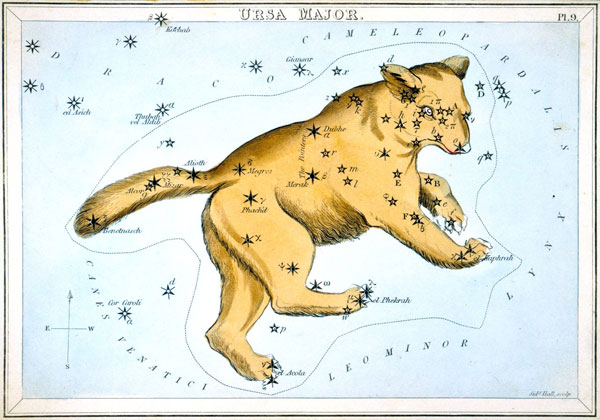Astronomy - IAU Standardizes 212 Traditional Star Names
Bringing order to chaos, the International Astronomical Union has approved standardized spellings and designations for the traditional names of 212 bright stars.

Ursa Major from Urania’s Mirror. Among the star names on this 1824 map of Ursa Major that are recognised by the IAU as official proper names are Alcor, Alioth, Dubhe, Megrez, Merak, and Mizar. Over the years, the star at the end of the tail has been known by two popular names, Alkaid and Benetnasch. On this card it is called Benetnasch, but the IAU Working Group on Star Names (WGSN) has chosen the more common alternative of Alkaid as its official name.
IAU
IAU
In a series of resolutions from 1922 to 1930, the International Astronomical Union approved standard spellings, abbreviations, and definitions for the 88 official constellations. Before this reform, several other constellations were recognized by some but not all astronomers: for instance, Quadrans Muralis, now preserved only in the name of the Quadrantid meteor shower. Even for the universally recognized constellations, there was no consensus where one stopped and another started. That caused grave problems with respect to newly discovered variable stars, because variable-star designations need to name the constellation that the star is in.
The IAU constellation reforms were wildly successful, and there was widespread hope that a similar procedure could be applied to traditional star names such as Sirius, the brightest star in the night sky. But that did not happen, for many reasons.
First, there was no urgent need among professional astronomers, because all the stars with traditional names also have official designations. Sirius, for instance, is unambiguously designated as Alpha Canis Majoris.
Second, whereas 88 constellations suffice to tile the entire sky, the star-naming problem is open-ended. Several thousand stars are visible to the unaided eye, and millions more are visible through modest-sized telescopes. No way are all of those going to get colloquial names -- but where to stop?
Finally, the star-name situation was far more chaotic than the constellations before the IAU reforms. The Yale Bright Star Catalog lists approximately 900 names that have been used at one time or another for approximately 400 stars. Most of those stars have multiple names, and a fair number of names have been applied to multiple stars. What a mess!
A New Standard for Star Names
The IAU has now created order out of this chaos, giving official status to 212 of these names. That brings the total number of IAU-approved star names to 227, including:
- 14 stars with exoplanets approved in December 2015
- 212 bright stars with traditional-sounding names, almost all of them in use by 1900
- 1 faint but very important star discovered in 1915: Proxima Centauri, the closest star to the Sun
With any luck, the IAU's standardization of star names will prove as successful as the constellations it standardized almost a century ago. Expect the myriad conflicting usages in popular books and magazines to converge toward the IAU names over the next several years. I am delighted to report that the IAU's 212 is almost identical to the 224 star names currently listed in the Sky & Telescope Stylebook; we will only need to change our usage in six cases.

The Persian astronomer Abd al-Rahman al-Sufi depicted Pegasus in his influential star atlas, and this copy was made around 1435 for the Samarkand astronomer-ruler Ulugh Beg. The constellation is shown as depicted on a celestial globe (i.e. mirrored as seen in the night sky). The four brightest stars, forming the easily recognisable "Square of Pegasus" visible in the autumn and the winter night skies, are labelled Matn al-Faras ("The Horse's Back"), Mankib al-Faras ("The Horse's Shoulder"), Surrat al-Faras ("The Horse's Navel") and Jinah al-Faras ("The Horse's Wing"). The IAU has adopted the names for these stars that were in common use in recent centuries: Markab, Scheat, Alpheratz, and Algenib. The modern constellation Pegasus also contains the star designated 51 Pegasi, which hosts the first exoplanet discovered around a solar-type star. As a result of the IAU's NameExoWorld contest, the star is now named Helvetios and its planet, designated 51 Pegasi b, is named Dimidium.
Bibliothèque nationale de France, Paris / IAU
Bibliothèque nationale de France, Paris / IAU
Why hasn't this been more of a problem in the past? Largely because most of these "popular" star names aren't really all that popular — and never have been. The name Sirius has been in continuous use with minor spelling variations for more than two millennia, but that's a rare exception. Roughly half the star names in the IAU list, while traditional sounding, were in fact invented after 1800. There was never a time when everyday people knew hundreds of stars by name — these "traditional" names are almost certainly used more widely today than ever before.
So there's no need to go out and memorize the IAU 212. I count just 18 star names that are universally recognized by amateur and professional astronomers, and all of these have been standardized, or nearly so, for 100 years. They are Aldebaran, Altair, Antares, Arcturus, Betelgeuse, Canopus, Capella, Castor, Deneb, Fomalhaut, Polaris, Pollux, Procyon, Regulus, Rigel, Sirius, Spica, and Vega.
If you can point out all 18 of these stars in the sky, you can pat yourself on the back and call yourself a highly educated stargazer. (Caveat: some of them are never visible if you live too far north or south of the equator.) But if you're curious about the meanings and derivations of the IAU 212 and many others, the recognized authority in the English language is A Dictionary of Modern Star Names by Paul Kunitzsch and Tim Smart.
No comments:
Post a Comment